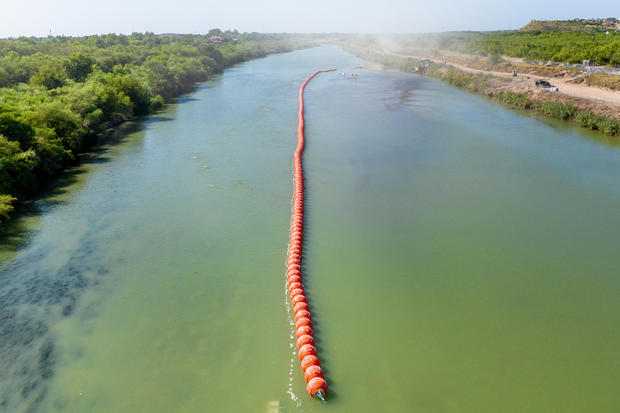Texas defends border buoys at hearing over Justice Department lawsuit
Austin, Texas — Lawyers for the state of Texas on Tuesday defended the state's decision to install a floating barrier in the Rio Grande along the border with Mexico, one day after Gov. Greg Abbott said the state had moved them following a federal government survey found that 80% of them were in Mexico.
The Justice Department sued Texas last month seeking to remove the barrier, arguing that the federal government should have been consulted before they were installed. Texas installed the buoys to deter migrants from crossing into the U.S. through the river, in between official ports of entry.
At a hearing in the case on Tuesday in the Texas capital, lawyers for both sides made their case before U.S. District Judge David Ezra. Lawyers for Texas argued the buoys are necessary to enforce border security, citing the more than 2.3 million border encounters so far this year. The Justice Department said the barrier has harmed the U.S. relationship with Mexico and should be dismantled.
What is the Justice Department's lawsuit?
The Justice Department's lawsuit alleges the installation of the buoys violated a law known as the Rivers and Harbors Appropriation Act. Under the law, a permit is required to construct structures in U.S. waters that are "navigable," or able to be traversed by boat. The Justice Department says Texas did not seek the approval from the U.S. Army Corps of Engineers before installing the buoys, which would have allowed the federal government to assess whether they posed any potential environmental and safety risks.

At Tuesday's hearing, the Justice Department called a U.S. State Department official to testify that the U.S.-Mexico relationship has been damaged by the buoys. Mexico's top diplomat said last week that "it is essential to remove the buoys installed in Mexican territory in the Rio Grande."
The dozens of large orange buoys are connected to enormous concrete blocks lying on the riverbed using chains roughly 40 feet long, according to testimony from a contractor from Cochrane USA, the company that installed the barriers. The buoys stretch about 1,000 feet near the border crossing at Eagle Pass, which Texas Department of Public Safety has alleged is "the center of gravity for smuggling."
At least two bodies have been recovered near the buoys. A Biden administration official told CBS News last month that the floating barriers have interfered with Border Patrol efforts to patrol the river and process migrants who reach U.S. soil. In one week, the official added, Border Patrol encountered dozens of injured or drowned migrants, including babies.
What is Operation Lone Star?
Abbott installed the buoys along the border earlier this summer as part of a border mission known as Operation Lone Star. Abbott has insisted he has "sovereign authority" over the southern border, and held a press conference there on Monday with four fellow GOP governors and several public safety officials defending Operation Lone Star.
Abbott has slammed the Biden administration for what he calls a lack of action along the border, and has said he was compelled to act.
While Abbott says he has received support from 14 other states for Operation Lone Star, the mission has been controversial. A medic and trooper for the Texas Department of Public Safety recently raised concerns about the buoys and overall treatment of migrants in an internal message that became public last month.
"The wire and barrels in the river needs to be taken out as this is nothing but [an] in humane trap in high water and low visibility," he wrote. "Due to the extreme heat, the order to not give people water needs to be immediately reversed as well."
The Texas Department of Public Safety has denied the allegations.
Are the border buoys located in Mexico or the U.S.?
On Monday, Texas officials acknowledged that the buoys had been moved following a federal survey that found 80% of them were technically on Mexico's side of the river. Texas officials have denied that the buoys crossed the border, but Abbott said Monday that they were being moved "out of an abundance of caution."
Whether the buoys were in Mexico or not could end up being a central part of Ezra's ruling. He told the state's lawyers on Tuesday that either the state intentionally placed the buoys in Mexico or they could drift with the current, putting them in Mexico. The state called the contractor as a witness to dispute that they could drift with the tide or were in Mexico.
It's unclear when Ezra, a Reagan appointee, will rule on the Justice Department's lawsuit. Written closing arguments are due later this week. Despite the highly charged controversy surrounding the buoys, the judge insisted Tuesday that politics will not influence his ruling.
The district court "is not Congress and it is not the president," he said. "I am not here to engage in — nor do I have any inclination to engage in — any type of political comment."
Camilo Montoya-Galvez contributed to this report.
- In:
- Texas
Disclaimer: The copyright of this article belongs to the original author. Reposting this article is solely for the purpose of information dissemination and does not constitute any investment advice. If there is any infringement, please contact us immediately. We will make corrections or deletions as necessary. Thank you.


